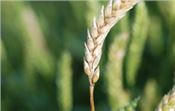|
Spraying Wheat With Fungicide To Control Scab Must Be Timely

Wheat with fusarium head blight.
Credit: Donald Groth, Louisiana State University AgCenter, Bugwood.org
COLUMBIA, MO.
After the horrible wheat scab year in 2015, farmers watch their maturing wheat crop with worry this spring. Some want to start spraying.
A University of Missouri agronomist says that spraying must be timely to be most effective.
“Don’t rush out to put on scab fungicide until flowering begins,” said Greg Luce, MU Extension small-grain specialist. “Ideal timing is at start of flowering. Being a little late is better than being too early.”
Last year, fusarium head blight, often called scab, cut yields and reduced seed quality. Many elevators turned away truckloads of scabby grain.
Besides yield loss, a big problem was that wheat carried vomitoxin, which can make grain unfit for livestock feed.
“With rain week after week, last year was perfect for scab to occur,” Luce said.
This year has been dry as wheat developed. However, if rains return as heads emerge, we could have issues this season, he said.
Forecasts across the Midwest call for more rain in the days ahead.
Warm, humid weather encourages spread of scab.
Fungicides can be used for control, but they do not provide complete control. It’s important to use recommended products, reading the label and applying the product timely and correctly.
In a weekly teleconference with MU Extension regional agronomists, Luce cautioned about spraying too early. Spraying before flowering won’t be as effective.
Timely scouting is required.
“Flowers on a wheat head don’t all appear at once.” Luce said. “Flowering starts in the middle of the head, then moves to the lower and upper segments.”
“Wait for emerging anthers to be visible,” he said. At bloom, flowerets extend a thin green spike called an anther.
There is a tight window for effective spraying, so prepare to spray when first flowers appear.
Research at the University of Illinois showed that approved scab fungicides worked best at beginning of flowering. The data showed that spraying five days after the ideal timing was better than spraying when no anthers were present.
Products that show the best control for scab are Caramba, Proline and Prosaro.
Early in the teleconference, MU specialists across the state reported uneven wheat growth in farm fields this spring.
Luce said he has seen that as well. He suspects the cause may be a combination of cold waves and lack of rain.
It was noted that it’s too late to apply fertility to speed growth on the spindly spots.
Scab control starts with selecting clean, quality seed at planting in the fall. Scab spores can be carried on seed into the next crop year.
Choose a variety with proven scab tolerance.
Luce said planting wheat after corn is worse than following soybeans. Corn can have stalk rot, caused by the same fusarium causing head scab in wheat.
Scabby wheat heads appear as white blanks. Those kernels, called tombstones, are shriveled, pink and low in test weight.
At harvest, combine fans should be set to blow the lightweight tombstones out of the grain.
When all of these practices are applied, the odds of satisfactory control of scab are much greater. Timely application of fungicide, while not perfect, greatly aids scab control, Luce said.
Regional extension agronomists are available across the state to analyze local scab conditions. ∆
|
|